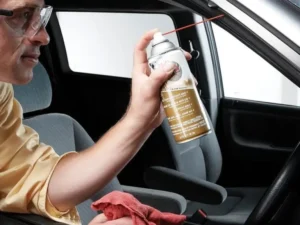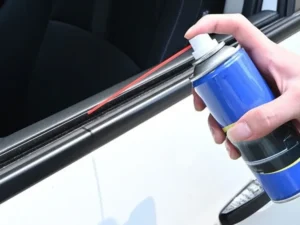Over time, car window channels can dry out and accumulate dirt, causing windows to open or close slowly—or even stick. Proper lubrication keeps your windows working smoothly and extends the life of your vehicle’s components.
Whether you’re a professional mechanic, a weekend DIYer, or simply someone who wants to keep their car in top condition, this guide will walk you through everything you need to know about lubricating your car window channels.
When Should You Lubricate Your Car Window Channels?
Maintaining the smooth operation of your windows is key to a comfortable and hassle-free driving experience. Here are six signs it’s time to lubricate your window channels:

1. Sticking or Jerky Window Movement
If your windows stick or move unevenly, it’s a clear sign of increased friction inside the tracks. Dirt, debris, or dried-out seals often cause this.
2. Squeaking Sounds
Hearing a squeak when rolling your windows up or down? That’s usually friction between the window glass and the rubber seals or felt-lined channels, often due to dryness or dirt buildup.
3. Difficulty Rolling Windows Up or Down
If operating the windows feels harder than usual, it likely means the channels need lubrication to restore smooth movement.
4. Visible Wear or Damage to the Window Seals
Check the rubber or felt around your windows. If you notice cracks, wear, or damage, it’s often due to lack of lubrication—and it’s a sign to act before further damage occurs.
5. Extreme Weather Conditions
High heat can dry out rubber seals, while freezing temperatures can make them brittle. Lubricate your window tracks before summer or winter to prevent weather-related issues.
6. As Part of Regular Maintenance
Adding window track lubrication to your routine maintenance schedule helps prevent problems and extends the life of your window components. Always follow your vehicle manufacturer’s maintenance recommendations when available.
Best Lubricants for Car Window Channels
Two main types of lubricants are recommended:
- Silicone Spray:
Ideal for weather extremes, silicone remains slick in both hot and cold conditions. It reduces friction, prevents premature wear, and provides long-lasting protection. - Dry Teflon Spray:
Excellent for repelling dirt and debris while offering smooth window operation. It’s clean, effective, and highly durable.

Both are excellent choices for automotive window tracks, offering reliable, long-term performance.
Step-by-Step Guide to Lubricating Car Window Channels

Step 1: Safety First
- Wear safety glasses and gloves to protect yourself from splashes and fumes.
- Work in a well-ventilated area to avoid inhaling any aerosol vapors.
- Park your car on a level surface to prevent accidental movement during the process.
Step 2: Preparation
Gather the following materials:
- Silicone or Dry Teflon lubricant spray
- Clean rags or cloths
- Optional: plastic straw nozzle for precise application
Familiarize yourself with your vehicle’s window system, focusing on locating the window tracks.
Step 3: Apply the Lubricant
- Lower the Window Fully:
Spray a generous amount of lubricant into the window channels, starting from the bottom. - Raise the Window One-Third:
Spray again along the exposed sections of the track. - Raise the Window Halfway:
Repeat the lubrication process. - Fully Close the Window:
Apply lubricant along the top section if accessible.
Pro Tip: Operate the window up and down between each spray to help distribute the lubricant evenly throughout the track.
Step 4: Test the Windows
- Roll the window up and down several times to ensure smooth movement.
- Listen for any squeaking sounds.
- If any roughness or noises persist, apply another light coat of lubricant and retest.
FAQ
Q: Can you use WD-40 on car window tracks?
A: Yes, but WD-40 is a water-displacing spray and evaporates quickly. For longer-lasting lubrication, use silicone or dry Teflon spray.
Q: Can Vaseline be used to lubricate windows?
A: Vaseline can work as a temporary solution but may attract dirt and grime. For best results, use a specialized automotive window lubricant.
Q: Is silicone spray slippery?
A: Yes. Silicone spray forms a slick, protective layer, making it ideal for reducing friction in window channels and seals.
Q: How long does silicone spray last?
A: Under typical conditions, silicone spray can last from several months to a few years. In ideal environments, some high-quality products may last even longer.
Summary
Lubricating your car window channels is an easy but essential maintenance task. By using a high-quality silicone or dry Teflon spray and following a careful application process, you can:
- Ensure smooth window operation
- Prevent premature wear
- Extend the life of your window seals and tracks
If you need any additional assistance or product recommendations, don’t hesitate to contact our professional support team. We’re here to help keep your vehicle running its best!
